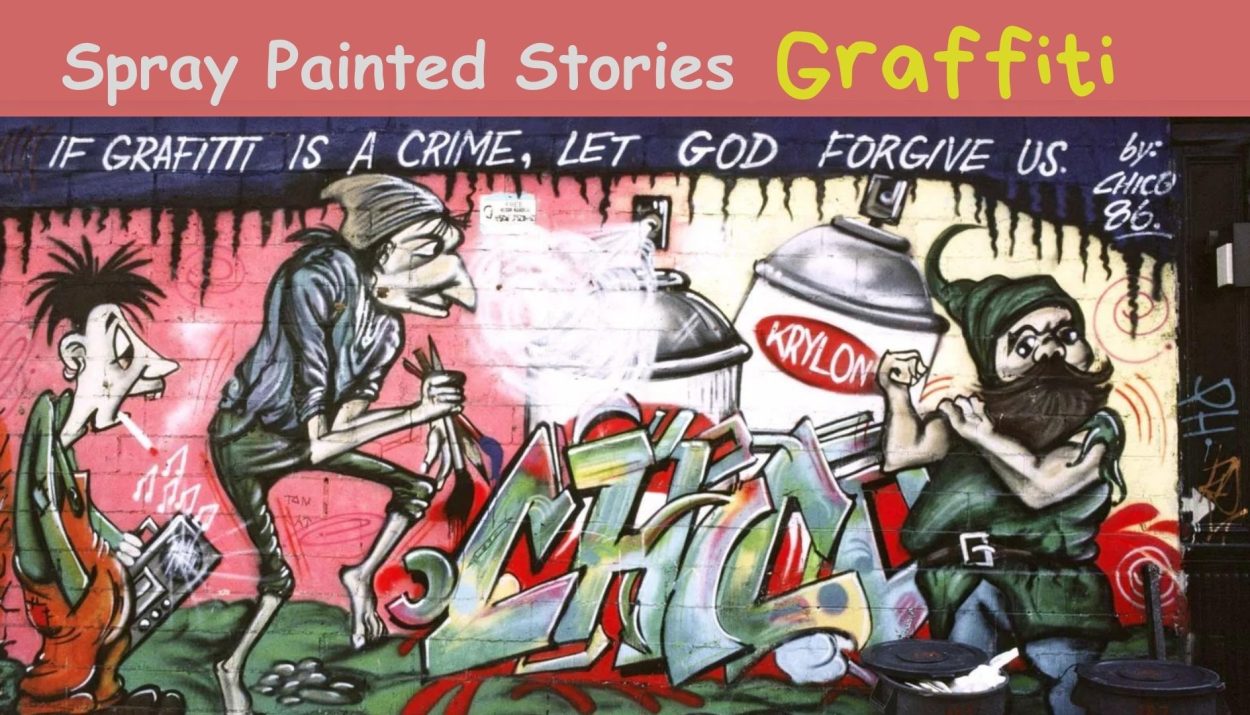In urban landscapes worldwide, graffiti has seamlessly integrated into the visual tapestry of cities. These vibrant and often provocative artworks, painted on walls, bridges, and buildings, serve as a canvas for self-expression, social commentary, and cultural identity. “Spray Painted Stories: Graffiti” delves into the dynamic world of urban art, exploring the unique stories and techniques behind these captivating forms of self-expression.
This art form can address matters related to identity, art, empowerment, and politics while also being associated with acts of vandalism. Graffiti, characterized by writing or scribbling on public property, boasts a history spanning thousands of years.
According to the Merriam-Webster Dictionary, graffiti is usually defined as unauthorized writing or drawing on a public surface. Similarly, the Oxford Advanced American Dictionary describes graffiti as drawings or writing done on a wall or in a public place without permission.
The History of Graffiti
Graffiti, as we recognize it today, boasts deep historical roots. It’s essential to trace its origins back to ancient civilizations, where inscriptions, drawings, and symbols adorned walls, caves, and temples. This early form of graffiti went beyond mere vandalism; it conveyed stories, beliefs, and cultural elements that transcended time.
Graffiti-like markings and inscriptions have been discovered on the walls of ancient Egyptian tombs, dating as far back as 3000 BC. In ancient Rome, graffiti was commonly employed for political and social commentary, with some examples preserved in the ruins of Pompeii. During the Middle Ages, graffiti-like carvings and inscriptions were prevalent in churches and cathedrals.
In the modern context, modern graffiti can be traced back to the late 1960s and early 1970s, primarily in New York City. It began as a subversive and often illegal art form, utilized by marginalized communities to voice their concerns and experiences. In response to social and political issues, graffiti artists transformed the streets into their canvas, leaving behind vibrant and thought-provoking creations.
The journey started in the mid-1960s when Darryl McCray, a 12-year-old, began inscribing his nickname, “Cornbread,” on the walls of the Youth Development Center in Philadelphia, a juvenile detention facility. After his release, he continued to make his mark on the streets of Philadelphia, tagging walls throughout the city. Simultaneously, in New York City during that same era, another young graffiti artist known as “Taki 183” (a combination of “Taki,” a nickname derived from his Greek name Demetrius, and “183,” his street number) emerged as one of the pioneering figures of the graffiti movement.
During the mid-1970s, as graffiti tags proliferated on New York City walls and subway cars were adorned with intricate new artworks daily, graffiti art faced increased political scrutiny. While many in the public admired the burgeoning art form, New York City mayors John Lindsay and Edward Koch pledged to address what they perceived as an expression of a more extensive “urban dilemma” in the city. These efforts posed a significant challenge to the graffiti writers of the 1970s.
Today, graffiti artists employ light, perspective, and intricate, lifelike precision to create optical illusions of depth and form. In many cities, graffiti has become more accepted as an art form. Some artists have transitioned from illegal tagging to creating large-scale murals and public art installations, often with the support of local governments and businesses.
The Social Impact
Graffiti serves as a unique reflection of the cultural, social, and political landscapes of the places where it thrives. It has provided a means of expression for marginalized groups, offering a platform for those who may not have another means to convey their ideas. Street art has the power to challenge the status quo, question authority, and inspire conversations about social justice and change.
Over the years, graffiti art has functioned as a means to revitalize and rejuvenate urban environments. By transforming drab walls and neglected structures into vibrant pieces of art, graffiti artists have contributed to community rejuvenation and the creation of unique, imaginative spaces. In some cities, graffiti has been embraced as a part of their cultural identity, fostering creativity and tourism while preserving their unique artistic heritage.
The impact of graffiti art extends into various other artistic realms, including graphic design, advertising, fashion, and streetwear. By pushing the boundaries of creative expression, graffiti artists have ignited the imaginations of countless individuals, inspiring them to break free from convention and produce groundbreaking works of art.
Graffiti is widely recognized as a public art form, with museums, art critics, and art institutions embracing it. Nevertheless, its significance remains deeply rooted in the hearts of many individuals within their neighbourhoods, emphasizing the critical elements of accessibility and inclusivity about their identity and community in their artistic expressions.
The Artists Behind the Art
Graffiti artists are the lifeblood of this movement. Many of them choose to remain anonymous, adopting pseudonyms to protect their identities while leaving an indelible mark on the cityscape. A few, however, have achieved global recognition, earning a place in galleries and museums.
Prominent graffiti artists like Banksy, Shepard Fairey, and Jean-Michel Basquiat have transcended the streets, with their works commanding significant attention and value in the art world. Their success serves as a testament to the influence of graffiti on contemporary culture.
Conclusion
Graffiti is more than just unauthorized drawings on walls; it is a powerful form of cultural expression with deep historical roots and a significant social impact. From its origins in the margins of society to its current position in galleries and museums, graffiti has evolved into a respected and influential art form. It continues to shape our cities, engage our communities, and provoke thought and dialogue, making it an enduring and captivating facet of contemporary culture.
References
The street art that expressed the world’s pain
Graffiti: History, Purpose, Types
